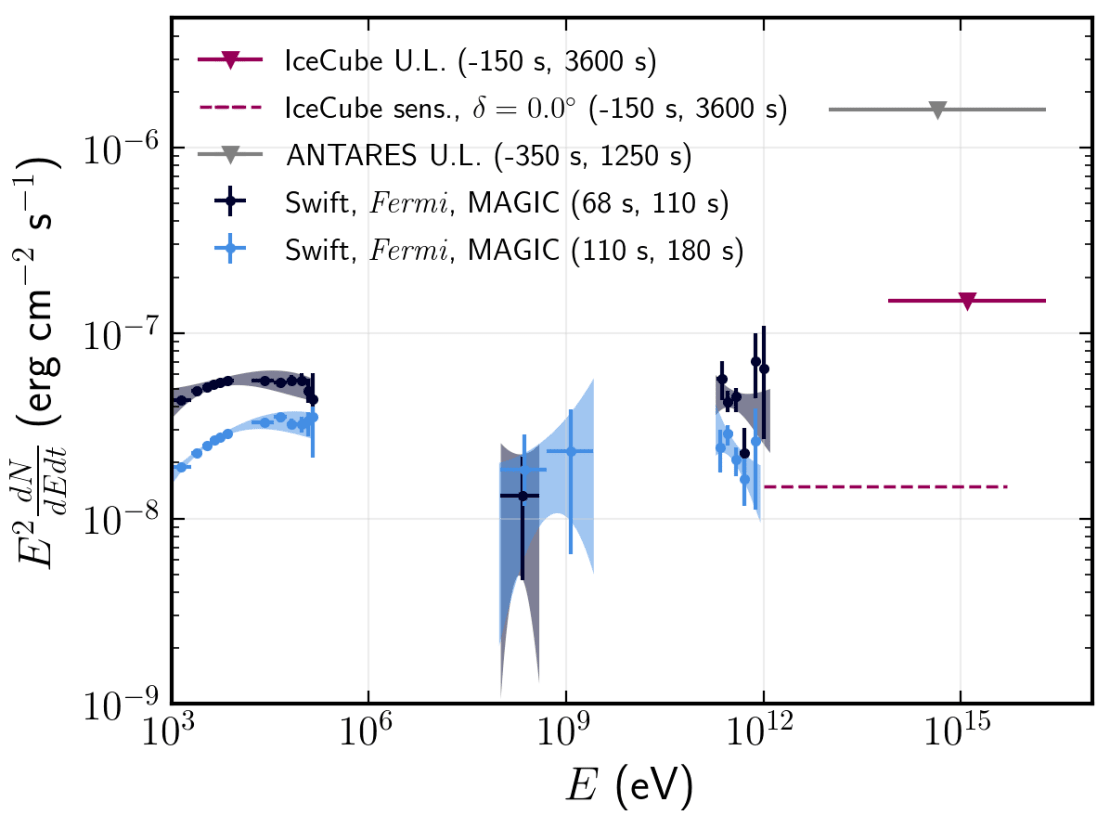The IceCube Neutrino Observatory, an array of over 5,000 light sensors embedded in a cubic-kilometer of ice at the South Pole, was built to detect astrophysical neutrinos: mysterious and nearly massless particles that carry information about the most energetic events in the cosmos. Every time IceCube sees something that might be a cosmic neutrino, it sends an alert to a network of telescopes and observatories around the world and in space, telling them to turn and look at that same spot in the sky. These other instruments see the universe in different ways; many detect photons of different wavelengths, from radio waves to gamma rays, while others detect different “messengers” entirely, like gravitational waves or neutrinos. Together, detections from different messengers give us a more complete picture of the cosmos.
The study of the universe with multiple channels—a field known as multimessenger astronomy—is valuable for investigating a number of questions, including learning about the sources of astrophysical neutrinos, one of IceCube’s main scientific goals. So rather than just waiting for neutrinos to come to IceCube, IceCube can also follow up on detections made by other telescopes. And since IceCube can observe the entire sky simultaneously and is “on” more than 99 percent of the time, it can provide unique and valuable insight for other observatories.
Since 2016, the IceCube Collaboration has used a fast-response analysis pipeline to perform follow-up neutrino searches on interesting detections in other messengers that might have neutrino counterparts. As of July 2020, the pipeline led to 58 analyses, none of which found significant neutrino signals but enabled researchers to constrain neutrino emission from some potential sources. The collaboration described their results in a paper recently submitted to The Astrophysical Journal.

“The motivation for this analysis is to take the idea of neutrino alerts and turn it on its head,” says Alex Pizzuto, a doctoral student at the University of Wisconsin–Madison and a lead on this analysis. “Instead of sending out interesting neutrinos to the community and letting observers follow up on our events, we take interesting events reported in other messengers, like photons, and check to see if there are neutrinos coming from the same object. And we do it all in real time.”
Pizzuto and his collaborators have been doing this since 2016 when they established a fast-response analysis pipeline. The pipeline monitors various channels where astronomers announce interesting observations (such as the Gamma-ray Coordinates Network and the Astronomer’s Telegram) and identifies potentially interesting detections. Then, IceCube researchers evaluate whether the target is a viable neutrino emitter and whether it would be useful for IceCube to check it out. If yes, the researchers determine a timeframe around the event of interest and use the pipeline to rapidly perform a statistical analysis of IceCube data to see if any neutrino candidate events correlate with the target in time and direction. When the analysis is complete, the researchers send out their results via the same channels they were monitoring in the first place.
As of July 2020, the pipeline has led to 58 analyses, none of which found a statistically significant signal of neutrinos. But the researchers were able to use the pipeline to put constraints on some of the source classes they studied, including fast radio bursts, extreme blazar flares, bright gamma-ray bursts, and gravitational waves. Pizzuto says that they are already seeing some of their limits incorporated into models of potential neutrino sources.
“Unlike most telescopes, IceCube observes the entire sky (including both hemispheres), all the time (including both day and night),” according to Justin Vandenbroucke, a UW–Madison physics professor and another lead on the paper. “So whenever a new astrophysical transient event is reported by another observatory, we know IceCube was also looking there then. Our pipeline enables us to rapidly search for neutrinos and report the results. This real-time approach to multimessenger astrophysics has enabled the key discoveries of the field so far, and will continue to in the future.”
Looking ahead, the researchers plan to continue running the pipeline. They hope that this analysis will identify a multimessenger source in the future. In the meantime, they are studying a variety of source classes with this tool. And there is a plan to use this pipeline to search for additional neutrinos coming from the same directions as the high-energy neutrinos that trigger IceCube alerts.
+ info “Follow-up of astrophysical transients in real time with the IceCube Neutrino Observatory,” IceCube Collaboration: R. Abbasi et al., The Astrophysical Journal 910 (2021) 1, 4, iopscience.iop.org, arxiv.org/abs/2012.04577